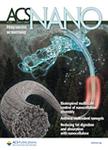版权所有:内蒙古大学图书馆 技术提供:维普资讯• 智图
内蒙古自治区呼和浩特市赛罕区大学西街235号 邮编: 010021

作者机构:Department of Chemistry National Taiwan University Taipei10617 Taiwan Graduate Institute of Nanomedicine and Medical Engineering Taipei Medical University Taipei11031 Taiwan Research Center for Applied Sciences Academia Sinica Taipei11529 Taiwan Nano Targeting & Therapy Biopharma Inc. Taipei10087 Taiwan International Ph.D. Program in Biomedical Engineering Taipei Medical University Taipei11031 Taiwan Neuroscience Research Center Chang Gung Memorial Hospital Taoyuan33305 Taiwan Department of Neurosurgery Chang Gung Memorial Hospital Taoyuan33305 Taiwan School of Medicine Chang Gung University Taoyuan33302 Taiwan Department of Neurosurgery New Taipei Municipal TuCheng Hospital New Taipei City23652 Taiwan Center for Cancer Translational Research Tzu Chi University Hualien970374 Taiwan Cancer Center Taipei Municipal WanFang Hospital Taipei116081 Taiwan SRS Medical Communications LLC ClevelandOH44124 United States
出 版 物:《ACS Nano》 (ACS Nano)
年 卷 期:2024年第18卷第20期
页 面:12716-12736页
核心收录:
学科分类:0831[工学-生物医学工程(可授工学、理学、医学学位)] 0710[理学-生物学] 07[理学] 0817[工学-化学工程与技术] 070203[理学-原子与分子物理] 0703[理学-化学] 0836[工学-生物工程] 0702[理学-物理学]
基 金:This research was mainly supported by the Ministry of Science and Technology of Taiwan (MOST 111-2124-M-001-003) the National Science and Technology Council (NSTC 112-2923-M-038-001 NSTC 112-2113-M-038-002 and NSTC 112-2113-M-038-004) the Higher Education Sprout Project by the Ministry of Education (MOE) in Taiwan (DP2-TMU-113-C-07) the National Health Research Institutes (NHRI-EX112-10911EC) TMU Industry-Academic Cooperation Program (A-105-074 and A-109-121) and the Investigator Award Academia Sinica Taipei Taiwan (AS-IA-110-M04). The authors acknowledge Ms. Ya-Yun Yang and Ms. Ching-Yen Lin at the Instrument Center of National Taiwan University for assistance with TEM. We also appreciate the technical support provided by the Core Facility and the Laboratory Animal Center at TMU
摘 要:Mesoporous silica nanoparticles (MSNs) represent a promising avenue for targeted brain tumor therapy. However, the blood-brain barrier (BBB) often presents a formidable obstacle to efficient drug delivery. This study introduces a ligand-free PEGylated MSN variant (RMSN25-PEG-TA) with a 25 nm size and a slight positive charge, which exhibits superior BBB penetration. Utilizing two-photon imaging, RMSN25-PEG-TA particles remained in circulation for over 24 h, indicating significant traversal beyond the cerebrovascular realm. Importantly, DOX@RMSN25-PEG-TA, our MSN loaded with doxorubicin (DOX), harnessed the enhanced permeability and retention (EPR) effect to achieve a 6-fold increase in brain accumulation compared to free DOX. In vivo evaluations confirmed the potent inhibition of orthotopic glioma growth by DOX@RMSN25-PEG-TA, extending survival rates in spontaneous brain tumor models by over 28% and offering an improved biosafety profile. Advanced LC-MS/MS investigations unveiled a distinctive protein corona surrounding RMSN25-PEG-TA, suggesting proteins such as apolipoprotein E and albumin could play pivotal roles in enabling its BBB penetration. Our results underscore the potential of ligand-free MSNs in treating brain tumors, which supports the development of future drug-nanoparticle design paradigms. © 2024 The Authors. Published by American Chemical Society.